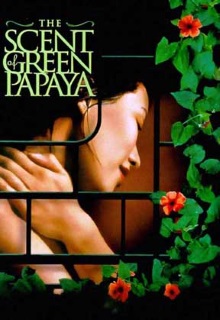
The Scent of Green Papaya is the very first Vietnamese film to be featured in this blog. It was the debut film for its director Trần Anh Hùng who since gone on to make other works that are also apparently considered to be quite notable. Like many of his films, it also stars the director’s wife Trần Nữ Yên Khê. What is most striking about this film however is that it perfectly immerses the audience in its setting of Vietnam in the 1950s, yet it is entirely filmed in a sound stage in France.
Told in two parts, the story has a young servant girl named Mùi as its protagonist. She arrives at the door of a rich family’s house at the age of ten where she is taken in and taught by an elderly servant. Contrary to what one might expect, the family actually treats her rather well though she of course still needs to do a great deal of work. The matriarch even comes to think of her as the daughter that she’d lost long ago. Her only source of grief is the mischevous youngest son of the family who keeps teasing and egging her on while she is trying to finish her chores.
There aren’t any surprises in this film, nor indeed much of a plot at all. Yet it impresses you over with its detailed and intimate portrait of what everyday life in Vietnam was like at that time. The camera follows Mùi’s motions as she goes about her daily routine, waking up, cutting papayas, preparing meals, wiping the floor and through her we learn the particular dynamics of the family she works for. It turns out, interestingly, that the mother actually runs the business and handles the money while the father lives a life of idleness, yet the mother is always subservient to the father and defers to him. Through it all, Mùi’s curious personality and her ability to find delight in everything wins over the audience.
The camera work here is remarkable and inventive as well. The house in which everything takes places is as much a star as the other performers and the director deftly arranges the camera to sweep across rooms as the characters move around it. The set does extend slightly to include a portion of the street outside the house and the peddlers in it but even so when you think about you’d expect things to feel claustrophobic since everything is shot on the same set. It is therefore a testament to how richly detailed the house is and how novel it feels to watch the normal routines of this Vietnamese family that the film never gets boring at all.
The second half of the story takes place after a ten-year skip. Mùi has grown up, and now played by Trần Nữ Yên Khê, is sent to work at the house of a family friend. There are some interesting bits, such as how the dialogue is so minimal that it feels like a stylized dance and how this house is much more modern and Westernized. Unfortunately, the character dynamics here are much less interesting since there are in fact only three characters in this portion of the film and interest drops even further once we discern that it is devolving into a mundane and implausible love story. The director’s wife may well be an excellent actress in other contexts, but she has almost no dialogue here and too little room to express much. I kept wishing that they’s stayed with the young version of Mùi and the more storied old house.
Most of the appeal of this film to me is how authentic it feels, but a non-Vietnamese naturally my judgment is suspect and I keep fearing that this might actually be a rather poor representation made by people who mostly live in France. Still, I haven’t been able to find any complaints online so perhaps my fears are groundless. I’m still disappointed by how lackluster the second half of the film is compared to the first half but on the whole this was a solid, and surprisingly educational, film to watch.
One thought on “The Scent of Green Papaya (1993)”